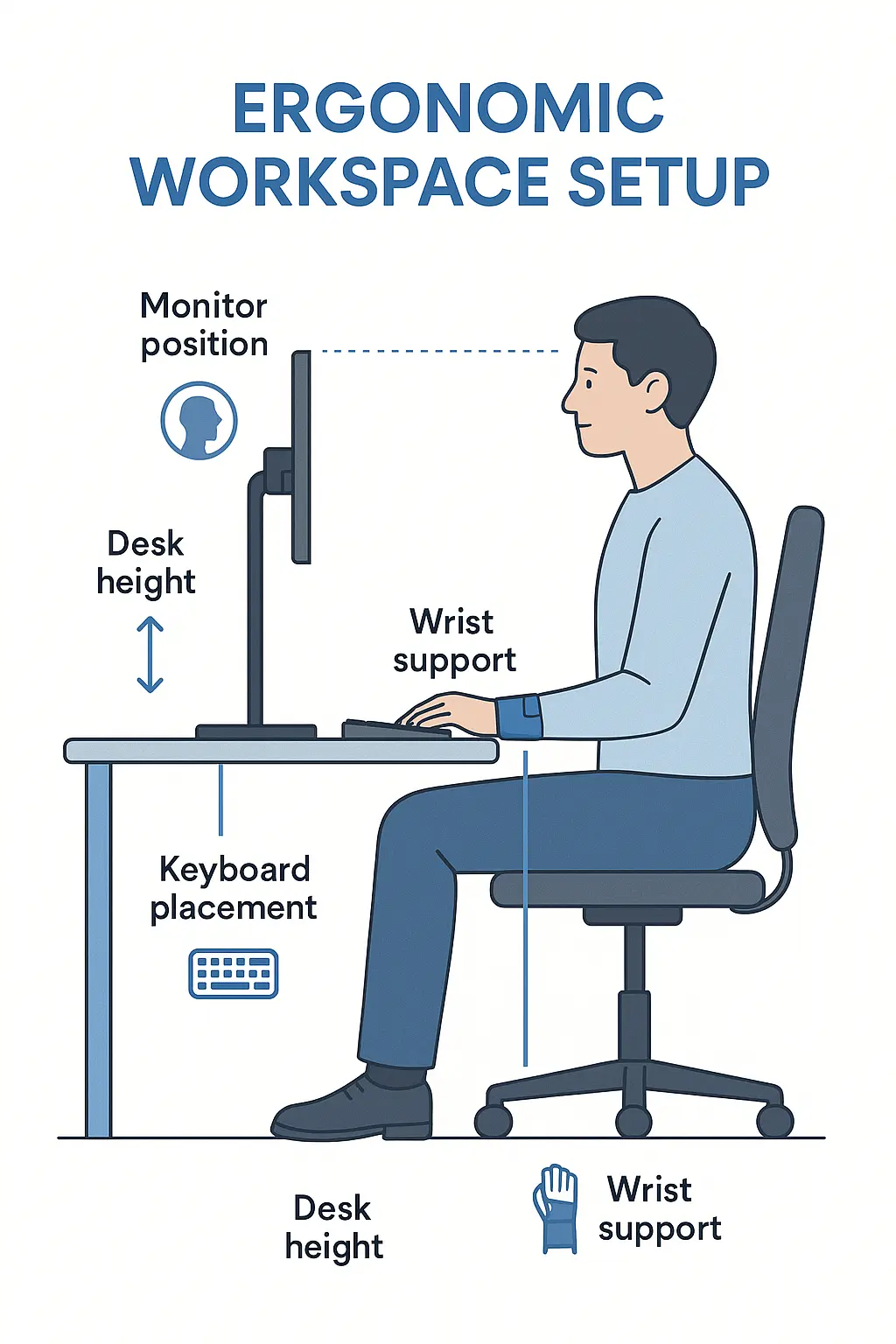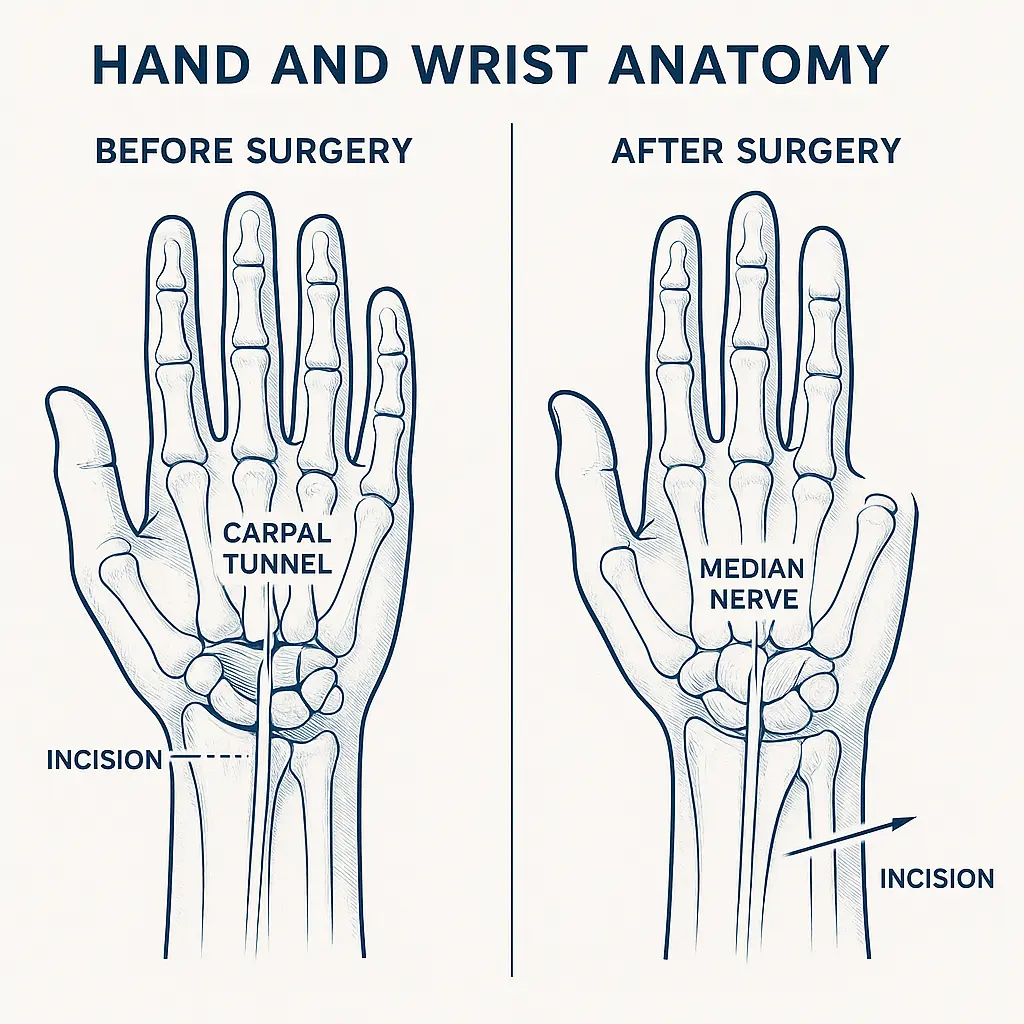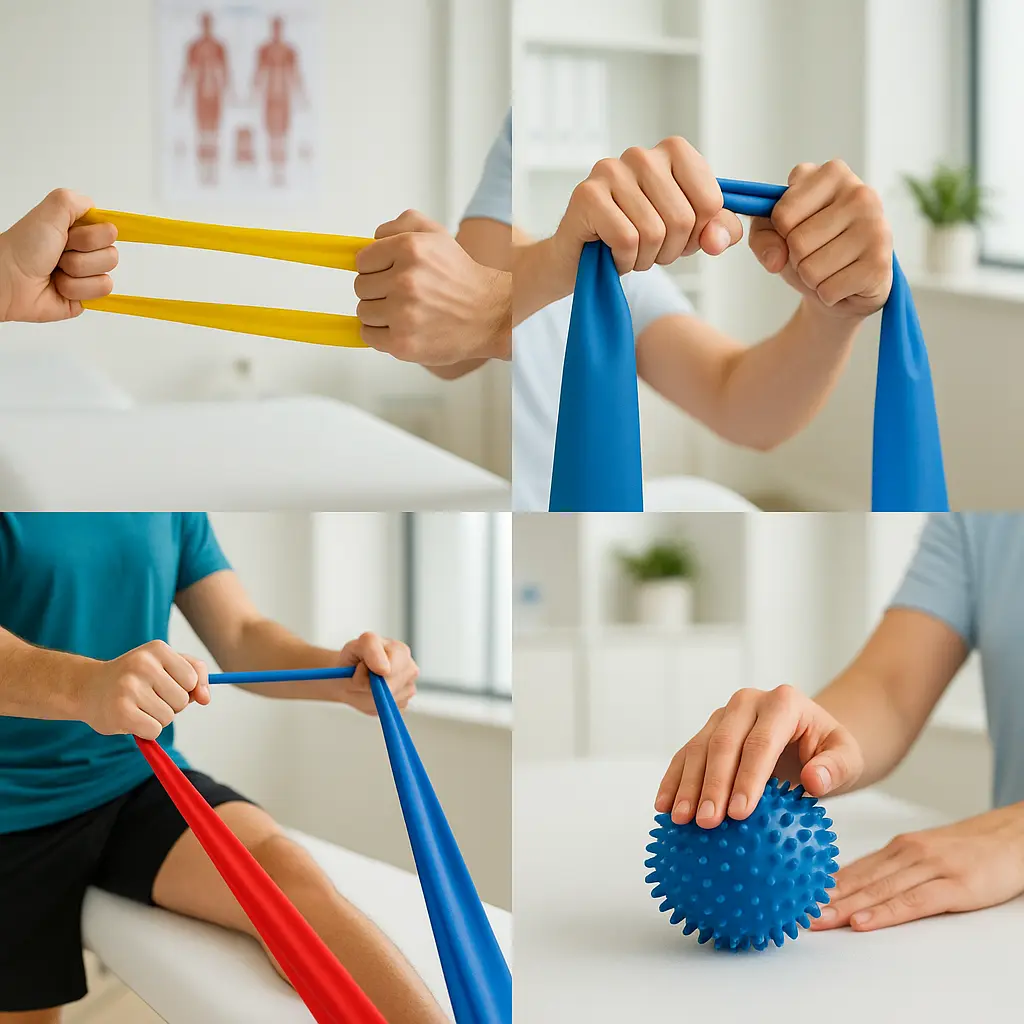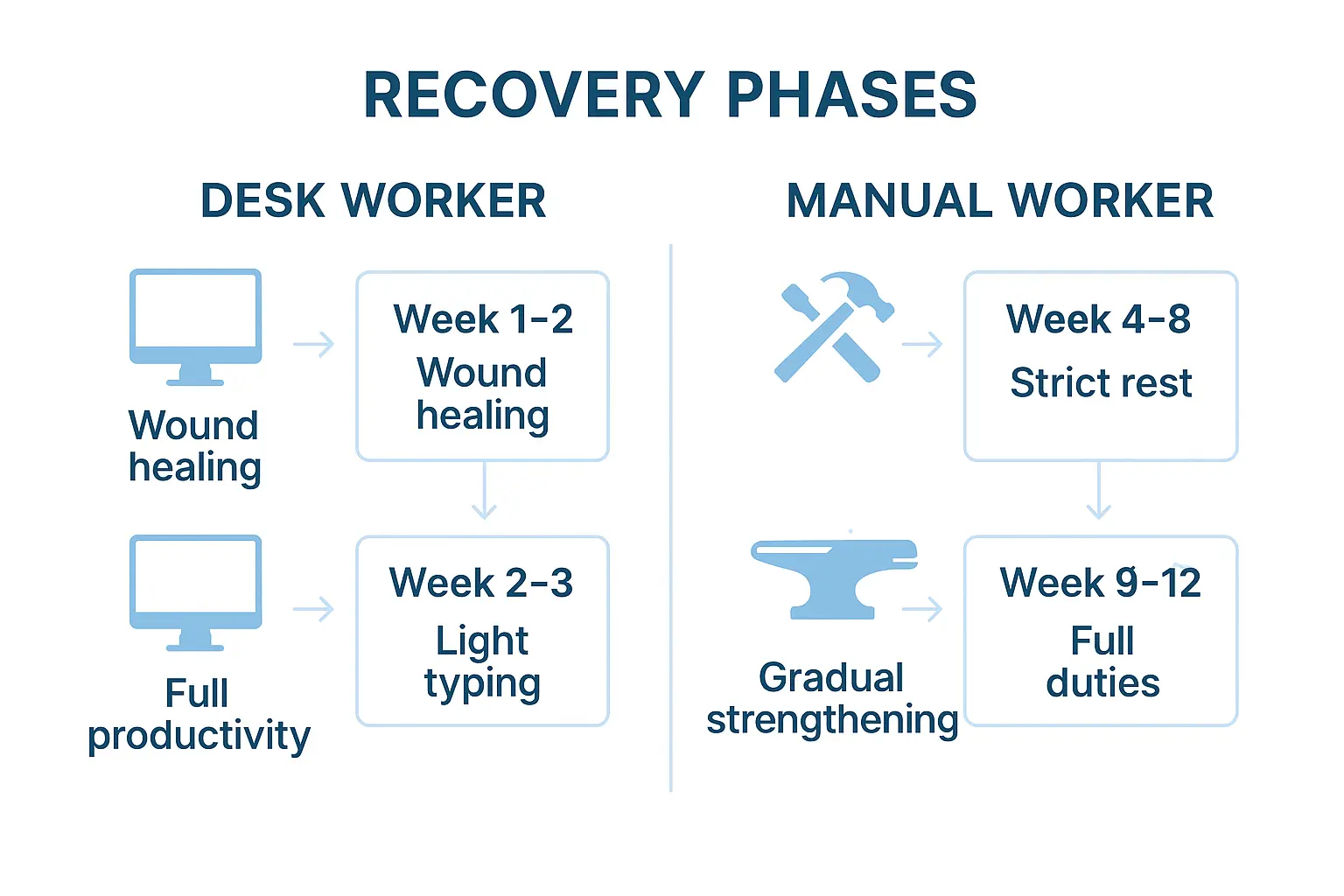Two workers sit in their surgeon's office, both scheduled for carpal tunnel surgery next week. One spends their days typing at a computer, while the other operates heavy machinery. Though they share the same diagnosis, their paths back to work will look dramatically different. The timeline for returning to productivity after carpal tunnel surgery isn't one-size-fits-all—it depends heavily on whether you're clicking a mouse or swinging a hammer.

• Desk workers typically return to work 1-3 weeks after carpal tunnel surgery, while manual laborers need 6-12 weeks for full recovery
• Job modifications and ergonomic adjustments can significantly accelerate return-to-work timelines for both work types
• Early intervention with physical therapy reduces recovery time and improves long-term outcomes regardless of occupation
• Gradual return-to-work programs help prevent re-injury and build confidence during the healing process
• Individual factors like age, overall health, and surgery type play crucial roles in determining specific recovery timelines
Carpal tunnel surgery, medically known as carpal tunnel release, involves cutting the transverse carpal ligament to relieve pressure on the median nerve. This procedure can be performed using two main techniques: open surgery or endoscopic surgery. Both methods aim to create more space in the carpal tunnel, but recovery experiences vary significantly based on your daily work demands.
The healing process follows a predictable pattern regardless of your occupation. Initial wound healing takes about 2-3 weeks, during which the incision site must remain clean and dry. Nerve regeneration begins immediately but can take several months to complete fully. Strength and function restoration varies dramatically between desk workers and manual laborers.
Understanding these fundamentals helps set realistic expectations for your return-to-work journey. The surgical team at specialized centers can provide personalized guidance based on your specific work requirements and recovery progress.
For office workers, the first two weeks focus on wound care and basic movement. Most desk workers can return to light duties within 7-10 days, especially if their dominant hand wasn't operated on. Key considerations during this phase include:
By the second week, most desk workers experience significant improvement in comfort levels. Light typing and mouse work become manageable with proper ergonomic support. This phase typically includes:
Most office workers achieve full productivity by the fourth week. However, some individuals may need up to 8 weeks for complete comfort during extended computer sessions. Long-term success factors include:

Manual workers face a more complex recovery journey due to the physical demands of their jobs. The first month requires strict activity limitations to prevent complications:
The second month marks the beginning of progressive strengthening. Physical therapy becomes crucial during this phase:
Most manual workers achieve complete recovery between 8-12 weeks post-surgery. This timeline can extend further for workers in particularly demanding roles:
The surgical approach significantly impacts recovery timelines. Endoscopic carpal tunnel release typically offers faster healing compared to traditional open surgery. Key differences include:
Endoscopic Surgery Benefits:
Open Surgery Considerations:
Personal health characteristics play crucial roles in determining recovery speed:
The level of workplace accommodation available dramatically affects return-to-work success. Progressive employers who offer modified duties and ergonomic support see better outcomes for their employees. Understanding your workplace rights regarding medical accommodations can facilitate smoother transitions back to productivity.
Creating an optimal workspace becomes even more critical after carpal tunnel surgery. Proper ergonomics can prevent re-injury and support comfortable productivity:
Essential Equipment:
Modern technology offers numerous tools to reduce wrist strain during the recovery period:
Voice Recognition Software:
Adaptive Hardware:
Flexible scheduling during recovery helps maintain productivity while protecting healing tissues:

Successful return-to-work programs for manual laborers often include transitional duty assignments. These programs benefit both employees and employers by:
Adaptive tools can significantly reduce wrist strain for manual workers:
Hand Tool Modifications:
Lifting and Handling Aids:
Structured exercise programs help manual workers regain the strength needed for their demanding jobs:
Phase 1: Range of Motion (Weeks 1-4)
Phase 2: Strengthening (Weeks 4-8)
Phase 3: Work Conditioning (Weeks 8-12)
Permanent changes to work environments help prevent carpal tunnel syndrome recurrence:
For Office Workers:
For Manual Workers:
Recognizing early symptoms of recurring carpal tunnel syndrome enables prompt intervention:
Understanding these warning signs helps workers seek appropriate care before symptoms become severe. Professional evaluation at specialized clinics can provide early intervention strategies.
Lifestyle modifications support long-term wrist health:
Exercise and Conditioning:
Nutritional Support:
Certain symptoms during recovery require immediate medical attention:
Regular follow-up appointments ensure proper healing and identify potential complications early. These visits typically include:

Comprehensive follow-up care helps optimize outcomes and prevent complications that could extend recovery timelines.
The recovery process affects more than just physical function. Mental health considerations include:
Common Emotional Responses:
Coping Strategies:
Gradual exposure to work-related activities helps build confidence:
Understanding the financial implications of carpal tunnel surgery helps with planning:
Direct Medical Costs:
Indirect Costs:
Coverage varies significantly depending on whether the condition is work-related:
Workers' Compensation Benefits:
Private Insurance Considerations:
Understanding your coverage options before surgery helps avoid unexpected expenses and ensures access to necessary care.
Healthcare professionals face unique challenges due to infection control requirements and patient care responsibilities:
Workers in these industries encounter specific workplace hazards during recovery:
These workers must balance customer service demands with recovery needs:
Newer surgical approaches continue to improve outcomes:
Modern rehabilitation tools accelerate recovery:
Progressive workplace programs support better outcomes:
SMART goals (Specific, Measurable, Achievable, Relevant, Time-bound) help track progress:
Week 1-2 Goals:
Week 3-4 Goals:
Week 5-8 Goals:
Keeping detailed records helps optimize recovery:
This documentation helps healthcare providers make informed decisions about activity progression and identifies potential complications early.
Strong support systems improve recovery outcomes:
Professional Support:
Personal Support:
Connecting with comprehensive care teams ensures access to all necessary resources throughout the recovery process.
The journey back to work after carpal tunnel surgery looks vastly different for desk workers versus manual laborers, but success is achievable for both groups with proper planning and realistic expectations. Desk workers typically return to productivity within 1-3 weeks, while manual laborers need 6-12 weeks for safe return to full duties. These timelines aren't set in stone—individual factors like age, overall health, surgery type, and workplace accommodations all play crucial roles in determining your specific recovery path.
The key to successful recovery lies in understanding your unique situation and working closely with healthcare providers to develop a personalized plan. Whether you're typing emails or operating heavy machinery, the principles remain the same: follow medical guidance, progress gradually, invest in ergonomic improvements, and listen to your body throughout the healing process.
Take action today by discussing your specific work demands with your surgical team, exploring workplace accommodations with your employer, and investing in the ergonomic tools that will support your long-term success. Remember that carpal tunnel surgery is highly successful when combined with appropriate lifestyle and workplace modifications.
Your return to work doesn't just mark the end of recovery—it's the beginning of a new chapter with improved hand function and the knowledge to prevent future problems. Contact specialized care providers to discuss your specific situation and develop the recovery plan that's right for your career and lifestyle.
SEO Optimization:
Meta Title: Carpal Tunnel Surgery Recovery: Desk vs Manual Work Timelines
Meta Description: Discover return-to-work timelines after carpal tunnel surgery. Desk workers: 1-3 weeks, manual laborers: 6-12 weeks. Get recovery tips and productivity strategies.